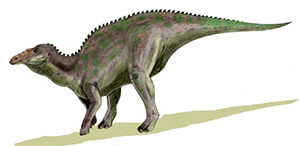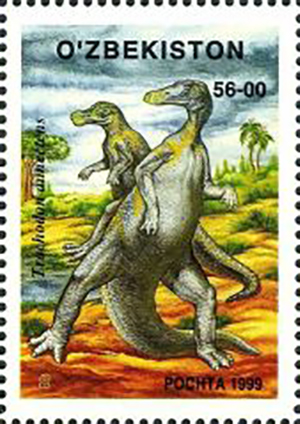Edmontosaurus annectens Marsh, 1892

(Da: en.wikipedia.org)
Phylum: Chordata Haeckel, 1874
Subphylum: Vertebrata Cuvier, 1812
Classe: Dinosauria Owen, 1841
Ordine: Ornithischia Seeley, 1888
Famiglia: Hadrosauridae Cope, 1869
Genere: Edmontosaurus Lambe, 1917
Descrizione
È stato un grande animale, fino a circa 12 metri di lunghezza, potenzialmente fino a 15 m, presenta uno degli esempi più suggestivi del muso "a becco d'anatra" comune agli hadrosauri. Ha una lunga storia tassonomica, i suoi campioni sono a volte stati classificati nei generi Diclonius, Trachodon, Hadrosaurus, Claosaurus agilis, Thespesius occidentalis, Anatosaurus e Anatotitan, prima di essere raggruppati in Edmontosaurus. Il cranio e scheletro di E. annectens sono ben noti. Edward Drinker Cope ha stimato la lunghezza di un esemplare in circa 12 m di lunghezza, con un teschio di 1,18 m di lunghezza. La stima della lunghezza del corpo è stata successivamente rivista scendendo a una lunghezza di 8,8 m; E. annectens potrebbe aver raggiunto lunghezze di oltre 15 m (49 ft) e oltre 10 tonnellate di pesorendendolo uno dei più grandi hadrosauridi.
Diffusione
Vissuto durante la fine del Cretaceo in quello che oggi è Sud America.
Sinonimi
= Anatosaurus copei Lull & Wright, 1942 = Thespesius saskatchewanensis Sternberg, 1926 = Claosaurus annectens Marsh, 1892.
Bibliografia
–Holtz, Thomas R. Jr. (2012) Dinosaurs: The Most Complete, Up-to-Date Encyclopedia for Dinosaur Lovers of All Ages, Winter 2011 Appendix.
–Rohrer, Willis L.; Konizeski, Richard L. (1 May 1960). "On the Occurrence of Edmontosaurus in the Hell Creek Formation of Montana". Journal of Paleontology. 34 (3): 464-466.
–Hicks, J.F., Johnson, K.R., Obradovich, J. D., Miggins, D.P., and Tauxe, L. 2003. Magnetostratigraphyof Upper Cretaceous (Maastrichtian) to lower Eocene strata of the Denver Basin, Colorado. In K.R. Johnson, R.G. Raynolds and M.L. Reynolds (eds), Paleontology and Stratigraphy of Laramide Strata in the Denver Basin, Pt. II., Rocky Mountain Geology 38: 1-27.
–Horner, J.R.; Goodwin, M.B.; Myhrvold, N. (2011). "Dinosaur Census Reveals Abundant Tyrannosaurus and Rare Ontogenetic Stages in the Upper Cretaceous Hell Creek Formation (Maastrichtian), Montana, USA". PLOS ONE. 6 (2): e16574.
–Udurawane, V. (2016). "Edmontosaurus, the great American duckbill dinosaur". Earth Archives.
–Horner, John R.; Weishampel, David B.; Forster, Catherine A (2004). "Hadrosauridae". In Weishampel, David B.; Osmólska, Halszka; Dodson, Peter (eds.). The Dinosauria (2nd ed.). Berkeley: University of California Press. pp. 438-463.
–Creisler, Benjamin S. (2007). "Deciphering duckbills: a history in nomenclature". In Carpenter Kenneth (ed.). Horns and Beaks: Ceratopsian and Ornithopod Dinosaurs. Bloomington and Indianapolis: Indiana University Press. pp. 185-210.
–"26b. What's In a Name: The Trachodon Story" ; Paper Dinosaurs (1824-1969): An Exhibition of Original Publications from the Collections of the Linda Hall Library.
–Glut, Donald F. (1997). "Anatotitan". Dinosaurs: The Encyclopedia. Jefferson, North Carolina: McFarland & Co. pp. 132-134.
–Norell, M. A.; Gaffney, E. S.; Dingus, L. (1995). Discovering Dinosaurs in the American Museum of Natural History. New York: Knopf. pp. 156-158.
–Osborn, Henry Fairfield (1909). "The Upper Cretaceous iguanodont dinosaurs". Nature. 81 (2075): 160-162.
–Cope, Edward D. (1883). "On the characters of the skull in the Hadrosauridae". Proceedings of the Philadelphia Academy of Natural Sciences. 35: 97-107.
–Ostrom, John H. (1964). "A reconsideration of the paleoecology of the hadrosaurian dinosaurs". American Journal of Science. 262 (8): 975-997.
–Marsh, Othniel C. (1893). "The skull and brain of Claosaurus". American Journal of Science. 3rd Series. 45 (265): 83-86.

|
Data: 13/12/1999
Emissione: Animali preistorici Stato: Uzbekistan Nota: Emesso in un foglietto di 8 v. diversi |
|---|